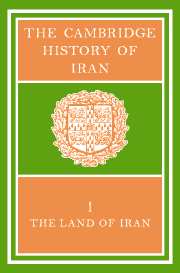Book contents
- Frontmatter
- PART 1 THE LAND
- 1 PHYSICAL GEOGRAPHY
- 2 GEOLOGY
- 3 GEOMORPHOLOGY
- 4 THE ORIGIN OF THE ZAGROS DEFILES
- 5 CLIMATE
- 6 SOILS
- 7 HYDROGRAPHY
- 8 VEGETATION
- 9 MAMMALS
- 10 ZOOGEOGRAPHIC ANALYSIS OF THE LIZARD FAUNA OF IRAN
- 11 ORNITHOLOGY
- PART 2 THE PEOPLE
- PART 3 ECONOMIC LIFE
- PART 4 CONCLUSION
- Bibliography
- Conversion Tables
- Fig. I. Iran: physiographical.
- Plate Section
- Fig 85. Soil potentiality map of Iran.
- References
10 - ZOOGEOGRAPHIC ANALYSIS OF THE LIZARD FAUNA OF IRAN
from PART 1 - THE LAND
Published online by Cambridge University Press: 28 March 2008
- Frontmatter
- PART 1 THE LAND
- 1 PHYSICAL GEOGRAPHY
- 2 GEOLOGY
- 3 GEOMORPHOLOGY
- 4 THE ORIGIN OF THE ZAGROS DEFILES
- 5 CLIMATE
- 6 SOILS
- 7 HYDROGRAPHY
- 8 VEGETATION
- 9 MAMMALS
- 10 ZOOGEOGRAPHIC ANALYSIS OF THE LIZARD FAUNA OF IRAN
- 11 ORNITHOLOGY
- PART 2 THE PEOPLE
- PART 3 ECONOMIC LIFE
- PART 4 CONCLUSION
- Bibliography
- Conversion Tables
- Fig. I. Iran: physiographical.
- Plate Section
- Fig 85. Soil potentiality map of Iran.
- References
Summary
INTRODUCTION
An understanding of present distribution patterns of organisms in South-west Asia is essential to any meaningful generalizations concerning biogeography on a world-wide basis. The vast arid physiographically complex tract stretching across all of North Africa, Southwest Asia, and north-western India today forms a barrier to the exchange of faunal elements of tropical and sub-tropical Africa with Europe, south-eastern Asia, and Central Asia. The extent to which communication between these faunas may have existed at various times in the past can be postulated only on the basis of our knowledge of palaeogeography, past climatic conditions, and the distribution of living and fossil organisms.
The area covered by this paper is delimited by the political boundaries of Iran, which might be regarded as one of the most geographically complex areas of South-west Asia, and is centrally located with respect to the mingling of elements of the North African, southern Asian, Central Asian and European herpetofaunas (Anderson, 1963).
While many systematic problems remain on all levels, it is nonetheless possible to make a few generalizations regarding the zoogeography of South-west Asia, and Iran in particular. Thus far no zoogeographic analysis of the whole of South-west Asia has been attempted, and only the most cursory remarks on the zoogeography of the amphibians and reptiles of Iran have been published (Blanford, 1876; Wettstein, 1951; Anderson, 1964). In this report an effort is made to answer in the broadest sense the following questions: (1) What are the major distributional patterns? (2) What are the historical origins of these patterns?
Keywords
- Type
- Chapter
- Information
- The Cambridge History of Iran , pp. 305 - 371Publisher: Cambridge University PressPrint publication year: 1968
References
- 13
- Cited by

